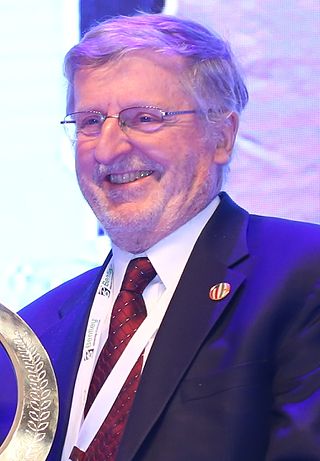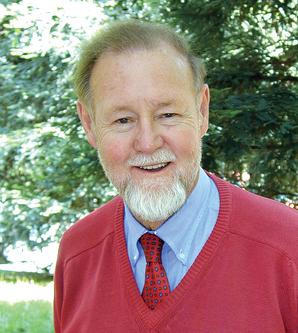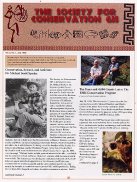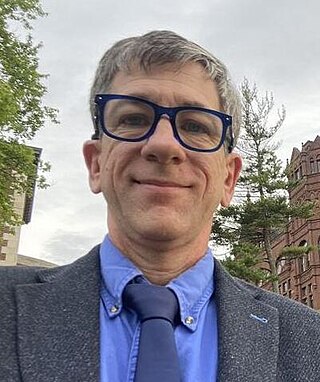
Environmental Systems Research Institute, Inc., doing business as Esri, is an American multinational geographic information system (GIS) software company headquartered in Redlands, California. It is best known for its ArcGIS products. With 40% market share as of 2011, Esri is one of the world's leading supplier of GIS software, web GIS and geodatabase management applications.

Waldo Rudolph Tobler was an American-Swiss geographer and cartographer. Tobler is regarded as one of the most influential geographers and cartographers of the late 20th century and early 21st century. He is most well known for coining what has come to be referred to as Tobler's first law of geography. He also coined what has come to be referred to as Tobler's second law of geography.

Michael Frank Goodchild is a British-American geographer. He is an Emeritus Professor of Geography at the University of California, Santa Barbara. After nineteen years at the University of Western Ontario, including three years as chair, he moved to Santa Barbara in 1988, as part of the establishment of the National Center for Geographic Information and Analysis, which he directed for over 20 years. In 2008, he founded the UCSB Center for Spatial Studies.

Jack Dangermond is an American billionaire businessman and environmental scientist, who in 1969 co-founded, with Laura Dangermond, the Environmental Systems Research Institute (Esri), a privately held geographic information systems (GIS) software company. As of July 2023, his net worth was estimated at US$9.3 billion.
ArcSDE is a server-software sub-system that aims to enable the usage of Relational Database Management Systems for spatial data. The spatial data may then be used as part of a geodatabase.

Roger Frank Tomlinson was an English-Canadian geographer and the primary originator of modern geographic information systems (GIS), and has been acknowledged as the "father of GIS."

The American Association of Geographers (AAG) is a non-profit scientific and educational society aimed at advancing the understanding, study, and importance of geography and related fields. Its headquarters is located in Washington, D.C. The organization was founded on December 29, 1904, in Philadelphia, as the Association of American Geographers, with the American Society of Professional Geographers later amalgamating into it in December 1948 in Madison, Wisconsin. As of 2020, the association has more than 10,000 members, from nearly 100 countries. AAG members are geographers and related professionals who work in the public, private, and academic sectors.

The Society for Conservation Geographic Information Systems (SCGIS) is an international non-profit society with around 1000 members in 80 countries.
The Esri International User Conference is an event dedicated to geographic information system (GIS) technology. It is held annually in the United States, usually for one week in July at the San Diego Convention Center in San Diego, California. The Esri UC dates back to 1981. In 2008, conference attendance grew to more than 14,000 attendees.

Geodesign is a set of concepts and methods used to involve all stakeholders and various professions in collaboratively designing and realizing the optimal solution for spatial challenges in the built and natural environments, utilizing all available techniques and data in an integrated process. Originally, geodesign was mainly applied during the design and planning phase. "Geodesign is a design and planning method which tightly couples the creation of design proposals with impact simulations informed by geographic contexts." Now, it is also used during realization and maintenance phases and to facilitate re-use of for example buildings or industrial areas. Geodesign includes project conceptualization, analysis, design specification, stakeholder participation and collaboration, design creation, simulation, and evaluation.
Launched in 2000, Esri's Education User Conference (EdUC), is organized and hosted by Esri's Educational Programs Team the weekend before the annual Esri International User Conference. Held in San Diego, California, during the month of July, the mission of the EdUC is to support and promote the use of geographic information systems (GIS) in educational research, instruction, administration, and policy. Over the years, it has grown into a sizable and popular event for those involved in using and teaching GIS in the greater educational community. This includes school teachers, youth program leaders, college and university instructors, community leaders, librarians, museum professionals, and administrators of educational institutions. The conference includes user presentation sessions, hands-on training workshops, exhibits, special interest group meetings, and a plenary session including a keynote presentation.
Esri Canada is the Canadian provider of enterprise geographic information system (GIS) software from Esri. GIS allows multiple layers of information to be displayed on a single map. A third of its offerings are professional services.
Cynthia Ann Brewer is an American cartographer, author, and professor of geography at Pennsylvania State University. Brewer's specialty relates to visibility and color theory in cartography. In 2023, she was awarded the International Cartographic Society's highest honor, the Carl Mannerfelt Gold Medal, for her distinguished contribution to the field.

Dawn Jeannine Wright is an American geographer and oceanographer. She is a leading authority in the application of geographic information system (GIS) technology to the field of ocean and coastal science and played a key role in creating the first GIS data model for the oceans. Wright is Chief Scientist of the Environmental Systems Research Institute (Esri). She has also been a professor of geography and oceanography at Oregon State University since 1995 and is a former Oregon Professor of the Year as named by the Council for the Advancement and Support of Education and the Carnegie Foundation for the Advancement of Teaching. Wright was the first Black female to dive to the ocean floor in the deep submersible ALVIN. On July 12, 2022, she became the first and only Black person to dive to Challenger Deep, the deepest point on Earth, and to successfully operate a side scan sonar at full-ocean depth.

Joseph Kerski is a geographer with a focus on the use of Geographic Information Systems (GIS) in education.

Technical geography is the branch of geography that involves using, studying, and creating tools to obtain, analyze, interpret, understand, and communicate spatial information.
George Frederick Jenks was an American geographer known for his significant contributions to cartography and geographic information systems (GIS). With a career spanning over three decades, Jenks played a vital role in advancing map-making technologies, was instrumental in enhancing the visualization of spatial data, and played foundational roles in developing modern cartographic curricula. The Jenks natural breaks optimization, based on his work, is still widely used in the creation of thematic maps, such as choropleth maps.
Arthur Getis was an American geographer known for his significant contributions to spatial statistics and geographic information science (GIScience). With a career spanning over four decades, Getis authored more than one hundred peer-reviewed papers and book chapters, greatly influencing GIScience and geography as a whole. The Getis-Ord family of statistics, one of the most commonly used in spatial analysis, is based on his and J. Keith Ord's work and is still widely used in the creation of hot spot maps.
David John Maguire is a British-American academic and IT executive currently serving as the Vice-Chancellor of the University of East Anglia (UEA). Formerly he was the Vice-Chancellor of the Universities of Dundee, Greenwich and Sussex, and a senior executive at Esri Inc, California for 13 years.
Duane Francis Marble was an American geographer known for his significant contributions to quantitative geography and geographic information science (GIScience). Marble had a 40-year career as a professor at multiple institutions, retiring from the Ohio State University and holding a courtesy appointment as Professor of Geosciences at Oregon State University afterward. His early work was highly influential in computer cartography and is regarded as a significant contributor to the quantitative revolution in geography. His work on constructing a "Model Curricula" in GIScience is listed as the starting foundation built upon by the Geographic Information Science and Technology Body of Knowledge.











